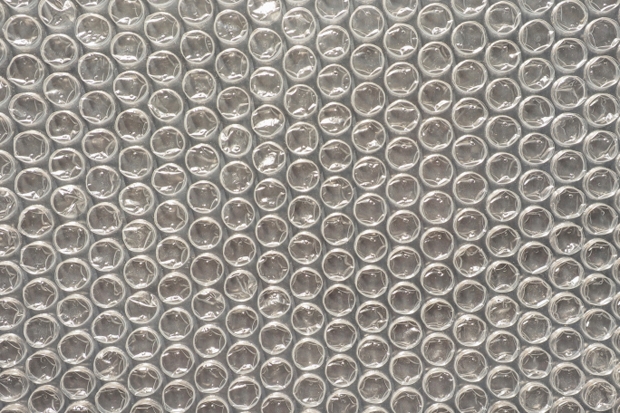It’s not quite as bad as we feared: Sealed Air, the company in New Jersey that makes bubble-wrap, is not yet discontinuing poppable bubble-wrap. But its newly designed sibling, non-poppable bubble-wrap, surely spells the end for the real thing: it’s cheaper to ship, because it leaves the factory airless and thus can be ‘flat-packed for your convenience’. The companies who receive it will need to buy an expensive pump to fill the reams of polythene with columns of air, and that air will be beyond the popping power of human fingertips.
Panic broke out among the bubble-wrap-popping millions across the globe on hearing the news of the threat to their habit earlier this month. The pastime is universally adored. Just thinking about it produces a pleasurable sensation and a longing to hear and feel the release of the circle of trapped air, which makes you desperate to pop the next one. Addicts hate coming across a piece of bubble-wrap and finding that someone has already been at it, leaving not a bubble behind.
If it is discontinued, how will we get our popping kicks? There will still be poppable seaweed, and for teenagers poppable pimples, and for rich people poppable caviar, but you’ll never again be able to pop in affordable bulk as you do now with any postal delivery of a breakable item. There are plenty of virtual bubble-wrap-popping games online (‘Stressed out? Relax by popping our virtual bubble-wrap!’) but they’re not as satisfying as the real thing, because the fingers can’t feel it. The question is: why do we love to pop?
It has been suggested by scientists that it’s an instinctive ancestral addiction, triggering memories of the repetitive grooming and insect-squishing done by our ape ancestors. That may be, and it tallies with my feeling that popping induces a sense of pleasure at destruction. We like the moment when the victim (even if it’s only a miniature polythene bubble) resists and then surrenders. Many of my favourite fidgety addictions involve small-scale destruction: I pick privet leaves as I walk past people’s houses and fold them briskly in half and half again, destroying them and relishing the sensation. I pick hawthorn berries and squelch them, I yank the seeds off grasses in an upwards flourish, and I love stamping on windfall crab-apples. In a small way, it’s power.
I accept that sex is one thing and popping bubble-wrap definitely another, but are the two distantly related? There’s a cultish phenomenon called ASMR — ‘autonomous sensory meridian response’ — which is defined as ‘the distinct, pleasurable tingling sensation in the head, scalp, back or peripheral regions of the body in response to visual, auditory, tactile, olfactory or cognitive stimuli’. It has also been defined as a ‘brain orgasm’ produced by certain sounds and sensations. Eleven million people have watched a YouTube video of a blonde woman with a very hushed voice tapping her long nails against the back of a wooden hairbrush, and running her nails gently along the bristles. These are all supposed to be delicious ‘triggers’, and watching such videos help people get to sleep, at the very least.
We need releases for our nervous energy, and resistance-followed-by-surrender sensations do seem to work. Switching on a 1970s television required you to turn a knob, feel the resistance, and then feel and hear the click of surrender. What’s more, you definitely knew the television was on, unlike nowadays when silent jabbing of the remote button often produces no result. So many clicks and clunks of our youth are no more: the extra-loud click of the typewriter when you jabbed the letter ‘T’ with the shift key held down; the ringing click of a bus-ticket machine, the clunk of a slam-door train. All of these were releases for pent-up energy as well as small everyday treats.
We still have vacuum-packed bliss to enjoy: snipping open a packet of Lavazza and feeling the softening of the foil as the air enters; hearing the ‘ah’ of air on opening a new tin of tennis balls; piercing the pristine film on a jar of Nescafé with the tip of a sharp knife; unscrewing the lid of a tube of tomato puree, reversing it and sinking the point down into the foil at the neck. Long may these continue.
Computer manufacturers know that we crave delicious sensations: hence the flying-balls-of-paper sound when you press the ‘Empty Trash’ button, and the card-shuffling sound when you start a game of smartphone patience. But the pleasure is halved, because you hear but don’t feel these. More and more things that used to make delicious noises have gone quiet in our touchscreen world. Cameras don’t click, so you’re not sure you’ve taken the photo. You press the office pass against a panel, causing doors to slide open: this is not a patch on the key, the click and the slam. The only new everyday noise I’ve noticed recently is that of a thousand tourists dragging pull-along suitcases through St Pancras International, but this can hardly be said to produce any kind of brain orgasm.






Comments